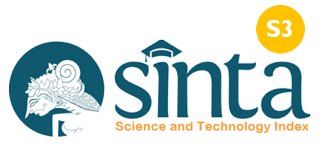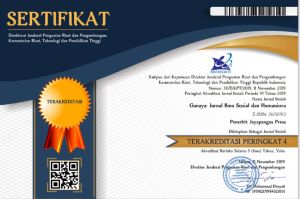Penerapan Pembelajaran Inovatif Untuk Meningkatkan Motivasi Dan Hasil Belajar Bola Voli Kelas VIII D Pada SMP Negeri 12 Surakarta
DOI:
https://doi.org/10.37329/cetta.v8i1.3863Keywords:
Bola Voli, Aktivitas Belajar, Kuesioner Motivasi, Hasil BelajarAbstract
Based on student observations in learning volleyball in class VIII D SMP Negeri 12 Surakarta, there are problems with student motivation and less innovative learning methods. On the other hand, the heavy ball causes students' hands to feel pain when performing technical movements or strokes, so it is necessary to innovate methods and media. The purpose of this study was to determine whether sponge plastic ball aids can increase volleyball learning activities, whether sponge plastic ball aids can improve volleyball learning outcomes. The research method is Classroom Action Research (PTK) which is carried out in two cycles. The research population was class 8D students of SMP Negeri 12 Surakarta, totaling 32 students. The research instruments were interview guidelines, questionnaires, and observation sheets. The data analysis technique used was quantitative descriptive analysis. The results showed that sponge plastic ball aids can improve volleyball learning activities, sponge plastic ball aids can improve volleyball learning outcomes. This is evidenced in the results of cycle I which showed an increase in the assessment of the knowledge aspect, there were 23 students (71.87%) who were complete and those who did not meet the criteria were 9 students (28.13%), the skill aspect showed an increase, namely 23 students (71.87%) in the complete category and 9 students or (28.13%) were not complete. In cycle II there was an increase in each aspect of better student learning, this was evidenced by the knowledge aspect showing an increase, namely 30 students (93.75%) in the complete category and 2 students (6.25%) in the incomplete category.
References
Anggi, R. (2020). Student Teams Achievement Division (STAD): Cooperative Learning Model In Improving Volleyball Under-Passing Results. Psikologi Pendidikan, 1(1), 25-32.
Basile, A. D. M. O., Kossivi, A., & Anne-marie, G. (2019). Masalah Pembelajaran Bola Voli Di Bentuk Kedua: Sebuah Studi Tentang Dua Kasus Pengajaran di Za-Tanta di Benin. International Journal of Physical Education, Sports and Health, 6(5), 200-210
Beutelstahl, D. (2005). Belajar Bermain Bola Volley. Bandung: CV. Pionir Jaya.
Bumburo, B., Ita, S., Wanena, T., Wandik, Y., & Putra, M. F. P. (2023). Permainan Bola Voli: Sebuah Tinjauan Konseptual. Multilateral: Jurnal Pendidikan Jasmani Dan Olahraga, 22(4), 38-44.
Cahyadi, E., Hariyanto, A., & Kartiko, D. C. (2021). Penerapan Metode Pembelajaran Inkuiri DAN Group Investigation Pada Pembelajaran PJOK Terhadap Partisipasi Dan Berpikir Kritis Siswa SMPN 4 Pamekasan. Jurnal Ilmiah Mandala Education, 7(2), 246-254.
Destriani, Y. H., & Solahuddin, S. (2021). Sosialisasi dan Pendampingan Hasil Pengembangan Teknik Pembelajaran Permainan Bola Voli Bagi Guru Penjaskes. Jurnal Dharma Pendidikan Dan Keolahragaan, 1(2), 1-8.
Dianti, Y. (2017). Pentingnya Pendidikan Karakter dalam Dunia Pendidikan. Angewandte Chemie International Edition, 6(11), 951-952.
Estari, A. W. (2020). Pentingnya Memahami Karakteristik Peserta Didik Dalam Proses Pembelajaran. Social, Humanities, and Educational Studies (SHEs): Conference Series, 3(3),1439-1444.
Fajrin, V. P., Wibowo, F. C., & Nasbey, H. (2024). Analisis Kebutuhan Modul Ajar Pemanasan Global Berbasis PBL untuk Meningkatkan Keterampilan Pemecahan Masalah dan Self-Efficacy Siswa. Cetta: Jurnal Ilmu Pendidikan, 7(1), 33-42.
Fernanda, M. R. O., Bekti, R. A., & Muharram, N. A. (2024). Penggunaan Alat Bantu Pembelajaran untuk Meningkatkan Hasil Belajar Passing Bolavoli pada Siswa X MAN 1 Kota Kediri Tahun Ajaran 2023/2024. Jurnal Kridatama Sains Dan Teknologi, 6(1), 189-199.
Guntur, G., Sukadiyanto, S., & Mardapi, D. (2014). Pengembangan Asesmen Hasil Belajar Penjasorkes Siswa Sma Pada Permainan Bolavoli. Jurnal Penelitian Dan Evaluasi Pendidikan, 18(1), 13-29.
Hamruni, I. A., Syaddad, Z., & Putri, D. I. I. (2021). Teori Belajar Behaviorisme Dalam Perspektif Pemikiran Tokoh-Tokohnya. Yogyakarta: Pascasarjana Fakultas Ilmu Tarbiyah dan Keguruan, UIN Sunan Kalijaga Yogyakarta.
Hamzah, B. U. (2008). Teori Motivasi dan Pengukurannya: Analisis di Bidang Pendidikan. Jakarta Timur: Bumi Aksara.
Hasmarita, S. (2018). Pengaruh Model Pembelajaran Teaching Games for Understanding (TGfU) terhadap Minat Belajar Penjas. Jurnal Olahraga, 4(1), 1-10.
Ilham, O. A., & Kholidman, I. (2019). Analisis Keterampilan Passing Bawah Dan Passing Atas Peserta Ekstrakurikuler Bola Voli Sma Negeri 2 Kota Sungai Penuh. Jurnal Cerdas Sifa Pendidikan, 8(1), 56-67.
Irmansyah, J., Sakti, N. W. P., Syarifoeddin, E. W., Lubis, M. R., & Mujriah, M. (2020). Pendidikan Jasmani, Olahraga, Dan Kesehatan Di Sekolah Dasar: Deskripsi Permasalahan, Urgensi, Dan Pemahaman Dari Perspektif Guru. Jurnal Pendidikan Jasmani Indonesia, 16(2), 115-131.
Lestari, D. F. (2021). Pengembangan Model Pembelajaran Aktivitas Jasmani Melalui Permainan Tradisional bagi Siswa Sekolah Dasar. Jurnal Pendidikan Jasmani, Olahraga Dan Kesehatan Undiksha, 8(1), 7-12.
Manan, A., & Bachtiar. (2017). Penggunaan Media Modifikasi Bola Plastik Untuk Meningkatkan Hasil Belajar Teknik Dasar Passing Bawah Dalam Bolavoli Pada Siswi Kelas VII di SMP Negeri 3 Pabuaran 2017. Seminar Nasional Pendidikan 2017, Universitas Muhammadiyah Sukabumi, 20-25.
Nasution, S. W. R. (2018). Penerapan Model Inkuiri Terbimbing (Guided Inquiry) dalam Meningkatkan Kemampuan Berpikir Kritis pada Pembelajaran Fisika. Jurnal Education and Development, 3(1), 1-5.
Putri, A. D., & Wijaya, A. (2024). Pengaruh Modifikasi Permainan Bola Voli terhadap Motivasi Belajar Siswa dalam Pembelajaran PJOK. SPRINTER: Jurnal Ilmu Olahraga, 5(1), 70-77.
Rochim, M. F. (2018). Peningkatan Keterampilan Passing Bawah Peserta Didik Dalam Permainan Bola Voli Melalui Metode Drill Dengan Bantuan Alat Modifikasi Bola Gantung. Jurnal Mahasiswa Pendidikan Olahraga, 3(2), 52-68.
Rozi, M. F., Putra, J., Suwirman, S., & Arsil, A. (2023). Motivasi Siswa Dalam Pembelajaran Pendidikan Jasmani Olahraga dan Kesehatan (PJOK). Wahana Didaktika: Jurnal Ilmu Kependidikan, 21(1), 143-153.
Sadler, D. R. (2018). Innovative Teaching Strategies for Active Learning. Educational Innovations Journal.
Suwardi, I., & Farnisa, R. (2018). Guru Dalam Proses Belajar Mengajar. Jurnal Gentala Pendidikan Dasar, 3(2), 181-202.
Verawati, & Desprayoga. (2019). Solusi Pembelajaran 4.0: Hybrid Learning. Prosiding Seminar Nasional Pendidikan Program Pascasarjana Universitas PGRI Palembang, 2, 999-1015.
Winarno, M. E. (2018). Pembelajaran Pendidikan Jasmani Olahraga dan Kesehatan. Jakarta: Erlangga.
Wulandari, P. J. (2021). Motivasi Siswa Kelas IV Dan V Terhadap Pembelajaran Bola Voli Di Sd Kanisius Sengkan Kabupaten Sleman Tahun 2020. Program Studi Pendidikan Guru Sekolah Dasar Penjas Jurusan Pendidikan Olahraga Fakultas Ilmu Keolahragaan Universitas Negeri Yogyakarta.
Downloads
Published
How to Cite
Issue
Section
License
Copyright (c) 2025 Kurniawan Ari Wibisono, Guntur Guntur

This work is licensed under a Creative Commons Attribution-ShareAlike 4.0 International License.
An author who publishes in the Cetta : Jurnal Ilmu Pendidikan agrees to the following terms:
- Author retains the copyright and grants the journal the right of first publication of the work simultaneously licensed under the Creative Commons Attribution-ShareAlike 4.0 License that allows others to share the work with an acknowledgement of the work's authorship and initial publication in this journal
- Author is able to enter into separate, additional contractual arrangements for the non-exclusive distribution of the journal's published version of the work (e.g., post it to an institutional repository or publish it in a book) with the acknowledgement of its initial publication in this journal.
- Author is permitted and encouraged to post his/her work online (e.g., in institutional repositories or on their website) prior to and during the submission process, as it can lead to productive exchanges, as well as earlier and greater citation of the published work (See The Effect of Open Access).
Read more about the Creative Commons Attribution-ShareAlike 4.0 Licence here: https://creativecommons.org/licenses/by-sa/4.0/.





